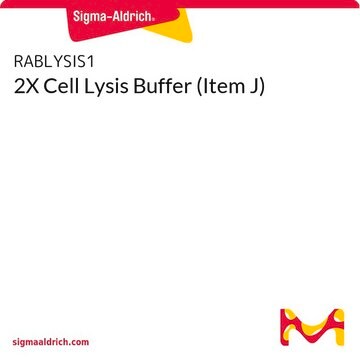C5789
Cell Dissociation Solution Non-enzymatic 1x
Prepared in Hanks′ Balanced Salt Solution without calcium and magnesium, sterile-filtered, BioReagent, suitable for cell culture
Synonym(s):
Cell Dissociation Reagent
Sign Into View Organizational & Contract Pricing
All Photos(1)
About This Item
Recommended Products
Quality Level
sterility
sterile-filtered
product line
BioReagent
form
solution
concentration
1 ×
technique(s)
cell culture | mammalian: suitable
pH
6.5-7.5
shipped in
wet ice
storage temp.
room temp
Looking for similar products? Visit Product Comparison Guide
Related Categories
General description
Cell Dissociation Solution Non-enzymatic buffer systems are alternative to the canonical trypsin based buffers for dissociation of adherent mesenchymal stem cell (MSC) monolayers.
Application
Cell Dissociation Solution Non-enzymatic 1x has been used in the dissociation of murine macrophage (RAW2647) cells, A549 pulmonary cells, islets cells and 2D cell and 3D mammospheres.
Special non-enzymatic formulation for gently dislodging adherent cell types from plastic or glass surfaces.
Storage Class Code
12 - Non Combustible Liquids
WGK
WGK 1
Certificates of Analysis (COA)
Search for Certificates of Analysis (COA) by entering the products Lot/Batch Number. Lot and Batch Numbers can be found on a product’s label following the words ‘Lot’ or ‘Batch’.
Already Own This Product?
Find documentation for the products that you have recently purchased in the Document Library.
Customers Also Viewed
Differential effects of RU486 reveal distinct mechanisms for glucocorticoid repression of prostaglandin E2 release
Chivers JE, et al.
European Journal of Biochemistry, 271(20), 4042-4052 (2004)
Jiaoying Jia et al.
Frontiers in cell and developmental biology, 9, 621187-621187 (2021-08-07)
Dysfunctions of neural stem cells (NSCs) often lead to a variety of neurological diseases. Thus, therapies based on NSCs have gained increasing attention recently. It has been documented that microRNA (miR)-421 represses the autophagy and apoptosis of mouse hippocampal neurons
Rosa G M Lammerts et al.
Frontiers in immunology, 11, 1643-1643 (2020-08-28)
Introduction: Proteinuria contributes to progression of renal damage, partly by complement activation on proximal tubular epithelial cells. By pattern recognition, properdin has shown to bind to heparan sulfate proteoglycans on tubular epithelium and can initiate the alternative complement pathway (AP).
Impact of integrin-matrix matching and inhibition of apoptosis on the survival of purified human beta-cells in vitro
Ris F, et al.
Diabetologia, 45(6), 841-850 (2002)
Evidence for lipopolysaccharide induced differentiation of RAW264. 7 murine macrophage cell line into dendritic like cells
Saxena RK, et al.
Journal of Biosciences, 28(1), 129-134 (2003)
Our team of scientists has experience in all areas of research including Life Science, Material Science, Chemical Synthesis, Chromatography, Analytical and many others.
Contact Technical Service









